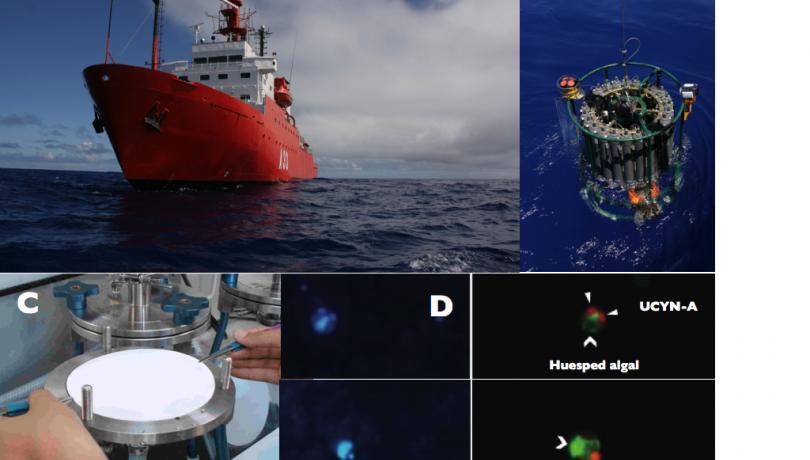New results of Malaspina project are published this month in three articles at the Journal of the International Society for Microbial Ecology. Led by scientists from the ICM, the studies confirm that among the thousands of studied microorganisms, about 50% correspond to new species. Two unexpected findings also reveal a high presence of fungi in the deep ocean and a great abundance of a symbiont organism recently discovered.
Studying the microbial diversity

New results of Malaspina project are published this month in three articles at the Journal of the International Society for Microbial Ecology. Led by scientists from the ICM, the studies confirm that among the thousands of studied microorganisms, about 50% correspond to new species. Two unexpected findings also reveal a high presence of fungi in the deep ocean and a great abundance of a symbiont organism recently discovered.
Studying the microbial diversity
One of the main goals of the Malaspina CONSOLIDER project was to escribe the overall biodiversity of microorganisms in the ocean, with special detail in the dark ocean species, from layers below 200 meters in depth, not reached by sunrays. As explained Silvia G. Acinas, ICM researcher involved in the three papers, microorganisms, viruses, bacteria, protozoa and microscopic algae, with sizes ranging from less than one micron to a few tens of microns "are dominant in abundance, biomass and activity, and they are responsible for most of the biochemistry of the ocean, as well as the main reservoir of genetic diversity of our seas".
In this sense, researchers have used molecular tools to study the DNA of these microorganisms and to describe their diversity from the obtained genetic sequences. Since the Malaspina expedition explored the main oceans in the world, the point of virew given by this diversity is more complete and global than prior studies, restricted to a particular region.
50% of microorganisms is unknown
One of the works (Salazar et al.) reveals that among the genetic sequences obtained from bacteria and archaea, 46% are new to science. In another work (Pernice et al.), the genetic sequences of eukaryotes that are unknown rise to a 59% of the total.
"Almost half of the prokaryotes (bacteria and archaea) we found might represent new species," explains Guillem Salazar, a PhD student in the ICM and main researcher of one of the papers. “What is surprising it is that even though each individual sample of deep sea contains about two thousand species, in the whole North and South Atlantic, North and South Pacific and Indian Ocean there are about 4,000 different species, only."
"Something similar happens with the deep-ocean protists (small eukaryotes), with only slightly bigger amount of new species, but a high variability between seasons and oceans", explains Massimo Pernice, main researcher of the second paper.
Symbionts and fungi in the ocean
Another unexpected finding is the large number of fungi in the deep Pacific samples. "We were surprised and we are working to describe these organisms and learn their way of life. Until this finding, it was thought that fungi were not abundant in the ocean", says Ramon Massana, ICM researcher who led the work.
In the third study, researchers have studied a recently discovered symbiotic relationship between a nitrogen-fixing cyanobacteria and unicellular algae. Cyanobacteria are unable to perform photosynthesis, and is feeded with the carbon fixed by the algae. In return, the algae get nitrites and nitrates (scarce in the ocean) from the nitrogen fixation performed by the cyanobacteria.
“Now, the new finding now is that this symbiosis, similar to that of leguminous plants, is very common in the global ocean, until 200 meters deep and from tropical to temperate latitudes, our coasts included," says Ana María Cabello, work leader. This wide distribution and abundance makes this symbiotic association an important contributor to the process of nitrogen fixation in the ocean.
"Thanks to the opportunity of participating in this expedition on a global scale, and the sampling effort in the farest and deepest waters, the results we are obtaining are very important and have a high international impact. These are the first attempts, but we are working on further studies to expand our knowledge of microorganisms that control marine biogeochemistry", says Josep Maria Gasol, research professor at the ICM and coordinator of the Microbiology section of the Malaspina expedition.
In the work have also been involved researchers from the Red-Sea Research Center in Thuwal, Saudi Arabia, the Spanish Institute of Oceanography in Gijon and the Canary Islands, the Institute of Marine Investigations of CISC in Vigo, yhe IMEDEA in the Balearic Islands, the University of Barcelona, the Autonomous University of Madrid and the Station Biologique de Roscoff, France.
Papers
- Massimo Pernice, Caterina Rodríguez Giner, Ramiro Logares, Júlia Perera-Bel, Silvia G. Acinas, Carlos M. Duarte, Josep M. Gasol, & Ramon Massana. (2015) Large variability of bathypelagic microbial eukaryotic communities across the world's oceans. The ISME J. doi: 10.1038/ismej.2015.170a
- Ana M Cabello, Francisco M Cornejo-Castillo, Nicolas Raho, Dolors Blasco, Montserrat Vidal, Stéphane Audic, Colomban de Vargas, Mikel Latasa, Silvia G Acinas & Ramon Massana (2015). Global distribution and vertical patterns of a prymnesiophyte–cyanobacteria obligate symbiosis. The ISME J. doi:10.1038/ismej.2015.147
- Guillem Salazar, Francisco M. Cornejo-Castillo, Verónica Benítez-Barrios, Eugenio Fraile-Nuez, Xose Antón Álvarez-Salgado, Carlos M. Duarte, Josep M. Gasol & Silvia G. Acinas. (2015) Global diversity and biogeography of deep-sea pelagic prokaryotes. The ISME J. doi:10.1038/ismej.2015.137